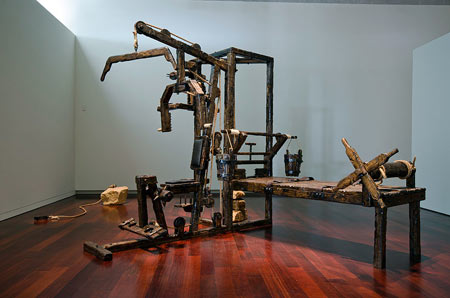
Partly inspired by the ground-breaking 1978 exhibit “New Image Painting” at the Whitney Museum of American Art, McNay Art Museum chief curator René Paul Barilleaux examines the current work of thirteen emerging and mid-career artists and art collectives using common materials to replicate everyday objects in “New Image Sculpture.”
Responding to the Spanish colonial architecture of the original mansion that houses the McNay, the Austin collective Okay Mountain created exercise equipment that might have been favored by the Spanish Inquisition, using rough-hewn wood poles to make a weight machine that resembles the infamous “rack” and an exer-cycle with a spear-pointed seat. El Paso artist Margarita Cabrera, whose work richly expresses her political convictions, created a full-scale, pink ceramic version of a John Deere tractor decorated with flowers and butterflies, merging the industrial and organic while celebrating farm laborers in modern, corporate agriculture.
Humor, satire and irony are strong currents running through most of the work. California artist Jean Lowe hilariously recreates a stereotypical psychiatrist’s office from the 1960s, complete with faux mid-century modern furniture, such as classic chairs by architect Marcel Breuer, along with a patterned Oriental rug, framed certificates and diplomas on an “I like me” wall, and finally flimsy bookshelves stocked with self-help best sellers such as “Misanthropes Make Bitter Lovers” and “How to Dominate Women.” Especially funny are the notes the psychiatrist writes on cartoonish yellow tablets, such as the doodles accompanying a complaint about how the patient went “on and on about his mother.”
Using wire, electrical conduit, vinyl, Mylar, metallic tape and styrofoam, Kevin Landers of Brooklyn recreates a rack containing shiny packages of snack chips as homage to convenience stores. And he uses brass, aluminum and tin to create knockoff watches displayed for sale in an old battered suitcase like the sidewalk vendors on New York’s Canal Street. Rather than perfectly duplicating the objects, Landers works from memory to ensure a rough, handmade look. California artist Libby Black responds to brand-name lust with her well-crafted but slightly off versions of a Louis Vuitton cot and a Chanel bag made with paper, hot glue and acrylic.
Some artists strive for straight-forward simulacra made with cheap materials. From the front, Los Angeles artist Kaz Oshiro’s replications of a Fender amp, a trash bin and wall cabinets look like the real thing, but from the back, you can see they are only facades made with acrylic paint on stretched canvas. Kiel Johnson, also from LA, makes detailed reproductions of film cameras, boomboxes and other outdated electronic devices, but in the muted tones of chipboard, cardboard, tape, glue and sealer.
In the show’s most ambitious installation, New York artist Jade Townsend created a full-scale room bursting with a cornucopia of consumer items lorded over by a droopy-cheek king resembling Richard Nixon. Behind the hoarder’s lair, animated old men are trading fisticuffs like a daffy pair of mechanical Keystone Kops.
Heirs to the legacy of Andy Warhol’s “Brillo Boxes” and Claes Oldenburg’s “Store,” these artists gently mock the excesses of contemporary consumer culture.
